Ironing Temperature: Complete Guide and Chart
Ironing can often feel like navigating a minefield. Use the wrong temperature, and you risk damaging your favorite clothes. But with the right knowledge, you can keep your garments looking pristine. This article will empower you with the information to confidently iron any fabric, preventing irreversible damage and extending the lifespan of your clothing.
Here, readers will find a complete guide about ironing temperature, a detailed chart, and tips and tricks, brought by experts.
1. Ironing Temperature Guide: The Ultimate Guide to Perfect Fabric Care
Clothing labels aren’t just suggestions; they’re vital instructions for garment care. These care labels provide valuable information about how to properly wash, dry, and, importantly, iron your clothes. Deciphering the fabric care symbols, especially the ironing symbols, is key to avoiding damage and maintaining the quality of your fabrics.
1.1 Decoding Ironing Symbols
Ironing symbols are universally recognized icons that indicate the appropriate ironing temperature and steam settings for a garment. Understanding these symbols is crucial for effective and safe ironing. Here’s a breakdown:
- One Dot (•): This signifies low heat, typically around 110°C (230°F). Suitable for delicate fabrics.
- Two Dots (••): Indicates medium heat, usually around 150°C (302°F). Appropriate for materials like wool and polyester blends.
- Three Dots (•••): Represents high heat, approximately 200°C (392°F). Best for durable fabrics such as cotton and linen.
- Iron with X (⨷): This symbol means “Do Not Iron.” These garments should not be subjected to any heat from an iron.
- Steam Iron Symbol: This symbol indicates that steam ironing is allowed. You can safely use the steam function on your iron to remove wrinkles from the garment.
- No Steam Iron Symbol: This symbol means steam should not be used while ironing. You should iron the garment without activating the steam function to avoid damage.
| Ironing Symbol | Temperature | Description |
|---|---|---|
| One Dot (•) | Low Heat | ~110°C (230°F) |
| Two Dots (••) | Medium Heat | ~150°C (302°F) |
| Three Dots (•••) | High Heat | ~200°C (392°F) |
| Iron with X (⨷) | Do Not Iron | No heat should be applied. |
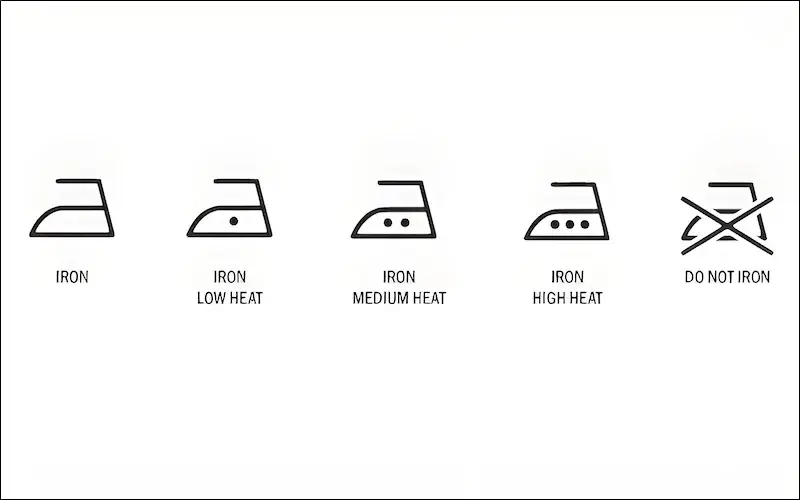
1.2 Fabric Types and Care Labels
Different fabrics have unique properties that dictate their care requirements. Always prioritize checking the care label on your garment before ironing. This is because the label is specifically tailored to that item’s material composition.
Ignoring the care label and guessing the ironing temperature can lead to irreversible damage, such as scorching, melting, or permanent shine. The importance of the care label cannot be overstated – it’s the manufacturer’s direct guide to preserving your clothes. Finding the care label is generally consistent; it’s often located on the inside seam, typically at the side or back neckline.
2. Ironing Temperature Chart: A Quick Reference
| Fabric Type | Temperature Setting | Steam | Additional Notes |
|---|---|---|---|
| Acetate | Low (110°C / 230°F) | No | Iron on the reverse side. Very sensitive to heat. |
| Acrylic | Low (110°C / 230°F) | No | Iron on the reverse side. Prone to melting. |
| Antoron | Low (110°C / 230°F) | No | Iron on the reverse side. |
| Arnel | Low (110°C / 230°F) | No | Iron on the reverse side |
| Caprolan | Low (110°C / 230°F) | No | Iron on the reverse side |
| Cotton | High (200°C / 392°F) | Yes/Optional | Can withstand high heat. Iron while slightly damp for best results. |
| Creslan | Low (110°C / 230°F) | No | Iron on the reverse side. |
| Dacron | Low (110°C / 230°F) | No/Optional | Iron on the reverse side. |
| Denim | High (200°C / 392°F) | Yes | Durable fabric. |
| Fortel | Low (110°C / 230°F) | No | Iron on the reverse side. |
| Kodel | Low (110°C / 230°F) | No | Iron on the reverse side. |
| Linen | High (200°C / 392°F) | Yes | Iron while slightly damp. |
| Metallics | Low (110°C / 230°F) | No | Use a pressing cloth. Avoid direct contact with the iron. |
| Nylon | Low (110°C / 230°F) | No | Iron on the reverse side. Prone to melting. |
| Orlon | Low (110°C / 230°F) | No | Iron on the reverse side. Another form of acrylic |
| Polyester | Medium (150°C / 302°F) | Optional | Iron on the reverse side or use a pressing cloth. |
| Perm Press | Medium (150°C / 302°F) | Optional | Usually requires less ironing. |
| Rayon | Medium (150°C / 302°F) | No | Iron on the reverse side. |
| Silk | Low (110°C / 230°F) | No | Iron on the reverse side. Use a pressing cloth. Very delicate. |
| Spandex | Low (110°C / 230°F) | No | Usually blended with other fabrics; follow guidelines for the dominant fiber. Avoid direct heat. |
| Suede | See the section below | See the section below | See the section below |
| Wool | Medium (150°C / 302°F) | Yes | Use a pressing cloth. |
| Velvet | See the section below | See the section below | See the section below |
| Cashmere | See the section below | See the section below | See the section below |
| Corduroy | See the section below | See the section below | See the section below |
| Synthetic Blends | Low/Medium | Refer to dominant fiber | Follow the care instructions for the most delicate fiber in the blend. |
3. Deep Dive into Fabric Types and Ironing Techniques
Understanding the specific characteristics of different fabrics is paramount to achieving perfect ironing results and garment preservation. The way a fabric reacts to heat and moisture directly influences the best ironing approach.
3.1 Delicate Fabrics (Low Heat)
Delicate fabrics, such as acetate, acrylic, silk, and nylon, are highly susceptible to heat damage. These materials can easily melt, scorch, or develop a permanent shine if exposed to high temperatures.
- Acetate: This fabric is extremely heat-sensitive. Always iron acetate on the reverse side using a low heat setting and no steam. A pressing cloth is highly recommended.
- Acrylic: Similar to acetate, acrylic fibers can melt under high heat. Use a low heat setting, no steam, and iron on the reverse side.
- Silk: Silk is renowned for its delicate nature. Iron silk on the reverse side while it’s slightly damp (but not wet). Use a low heat setting and a pressing cloth to protect the fabric’s sheen.
- Nylon: This synthetic material is prone to melting. Use a low heat setting, no steam, and iron quickly on the reverse side.
- Lace: When ironing lace, always use a press cloth to protect the delicate fabric
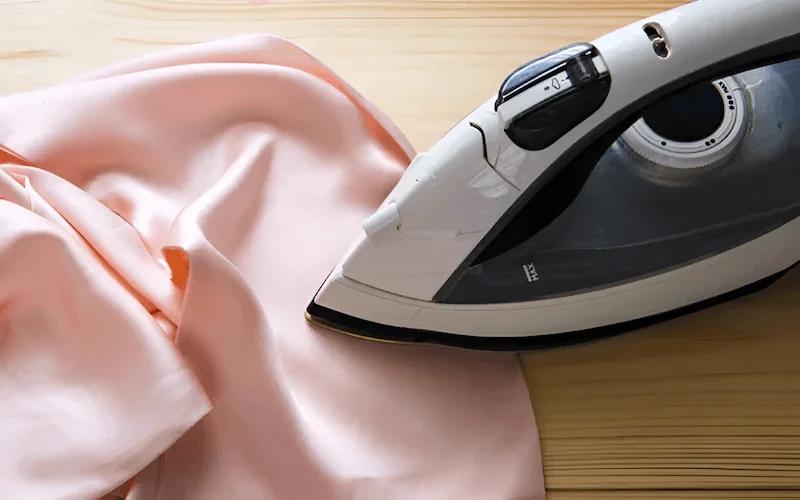
3.2 Moderate Fabrics (Medium Heat)
Moderate fabrics, including polyester, rayon, wool, and many synthetic blends, require a medium heat setting. These fabrics are less prone to melting than delicate fabrics but can still be damaged by excessive heat.
- Polyester: Iron polyester on the reverse side or use a pressing cloth to prevent shine. A medium heat setting is usually sufficient, and steam can be used sparingly.
- Rayon: This fabric can shrink or become misshapen with excessive heat. Iron rayon on the reverse side using a medium heat setting and no steam.
- Wool: Wool benefits from steam ironing, but direct contact with a hot iron can damage the fibers. Use a medium heat setting and a pressing cloth. The steam helps to relax the fibers and remove wrinkles.
- Synthetic Blends: For synthetic blends, always follow the care instructions for the most delicate fiber in the blend. Generally, a medium heat setting with or without steam (depending on the blend) is appropriate.
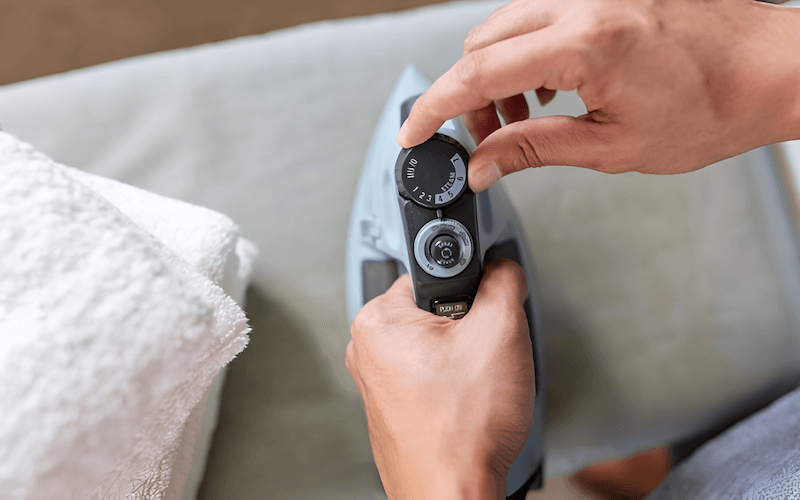
3.3 Durable Fabrics (High Heat)
Durable fabrics like cotton, linen, and denim can withstand high ironing temperatures. These fabrics often require higher heat and steam to effectively remove wrinkles.
- Cotton: Cotton is very heat-tolerant. Use a high heat setting and steam for optimal wrinkle removal. Ironing cotton while it’s slightly damp yields the best results.
- Linen: Linen is known for its tendency to wrinkle heavily. Use a high heat setting and plenty of steam. Ironing linen while it’s damp is highly recommended.
- Denim: Denim is a sturdy fabric that can handle high heat. Use a high heat setting and steam to smooth out wrinkles and creases.
3.4 Special Fabrics
Steam is yes, but use press cloth:
- Arnel: Arnel is a triacetate fiber, also heat-sensitive. Iron it on the reverse side with a low heat setting (110°C or 230°F) and avoid using steam.
- Caprolan: This is a type of nylon. Iron on the reverse side at a low heat setting (110°C or 230°F) and without steam. Like other nylons, it’s prone to melting.
- Creslan: Creslan is an acrylic fiber. Iron it on the reverse side using a low heat setting (110°C or 230°F) and no steam. It behaves similarly to other acrylics, being sensitive to high temperatures.
- Fortel: Fortel is another polyester. Low heat (110°C or 230°F) and no steam are recommended. Iron on the reverse side.
- Metallics: Metallic fabrics require very gentle handling. Use a low heat setting (110°C or 230°F) and absolutely no steam. The most important tip is to use a pressing cloth to prevent direct contact between the iron and the metallic fibers, which can easily be damaged or discolored.
- Suede: Never iron suede directly. The heat and pressure will flatten the nap and permanently damage the texture. For wrinkles, the best approach is to use a garment steamer, holding it several inches away from the fabric. If you don’t have a steamer, you can hang the garment in a steamy bathroom. For serious creases or cleaning, it’s best to take suede to a professional cleaner.
- Velvet: Like suede, velvet should not be ironed directly. Ironing will crush the pile and leave permanent marks. Use a garment steamer, holding it away from the fabric. Alternatively, hang the velvet garment in a steamy bathroom. For best results, professional cleaning is often recommended.
- Cashmere: Low heat setting (110°C or 230°F). Steam is yes, but use press cloth
- Corduroy: Corduroy is another pile fabric that should not be ironed directly. If you must iron it, turn the garment inside out and use a low heat setting with steam. It’s even better to use a pressing cloth between the iron and the fabric. The best approach, however, is to use a garment steamer to avoid crushing the cords.
- Spandex: Spandex is often blended with other fibers. Generally, a low heat setting (110°C or 230°F) and no steam are recommended. Avoid direct heat, and follow the care instructions for the most delicate fiber in the blend. Spandex is very heat-sensitive and can lose its elasticity if overheated.
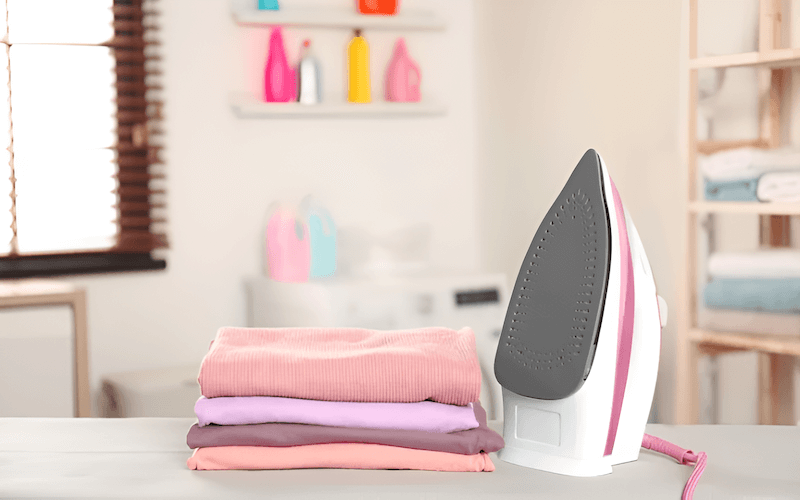
4. Essential Ironing Tips and Tricks
Beyond choosing the correct temperature, mastering several key techniques can significantly improve your ironing results and protect your garments.
4.1 Preparing Your Iron and Ironing Board
- Choose the Right Iron: Select an iron with adjustable temperature settings and a steam function. A clean soleplate (the bottom of the iron) is crucial for preventing damage.
- Ironing Board Setup: Use a sturdy, well-padded ironing board. Ensure the ironing board cover is clean and smooth. A heat-reflective cover can improve ironing efficiency.
- Clean Iron: Maintain the iron’s cleanliness.
- Soleplate: Make sure to clean it periodically.

4.2 Using Steam Effectively
- When to Use Steam: Steam is excellent for removing wrinkles from durable fabrics like cotton and linen. It also helps to relax the fibers of wool and other materials.
- Benefits of Steam: Steam penetrates the fabric, making it easier to smooth out wrinkles. It can also help to refresh garments and remove odors.
- Avoid Water Spots: Ensure your iron is hot enough to produce steam, not just hot water, which can leave spots on fabrics.
- Fabric Type Considerations: Avoid using steam on delicate fabrics like silk, acetate, or nylon, as it can cause watermarks or damage.
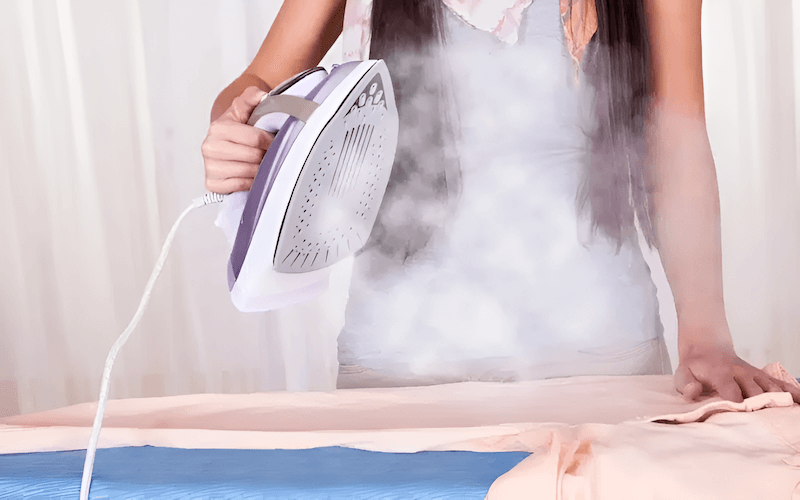
4.3 Ironing Techniques
- Reverse Side Ironing: Ironing garments inside out protects the outer surface from direct heat, preventing shine, especially on dark-colored fabrics or materials like polyester and rayon.
- Pressing Cloth: A pressing cloth (a thin piece of cotton or linen) acts as a barrier between the iron and the fabric, protecting delicate materials from scorching or melting.
- Ironing in Sections: Work in small sections, moving the iron smoothly and continuously. Avoid leaving the iron in one spot for too long.
- Avoid Stretching: Be gentle when ironing, especially with knits and delicate fabrics. Avoid pulling or stretching the fabric, which can distort its shape.
- Pleats, Ruffles: Pleats and ruffles require special care to maintain their shape and appearance.
4.4 Troubleshooting Common Ironing Problems
- Scorched Fabric: If you accidentally scorch fabric, act quickly. For light scorch marks, try treating the area with hydrogen peroxide or white vinegar (test on an inconspicuous area first). For heavier scorching, the damage may be irreversible.
- Melted Fabric: If synthetic fabric melts onto the iron, unplug the iron immediately and let it cool completely. Once cool, try to gently scrape off the melted residue. You can also try using a specialized iron cleaner.
- Stubborn Wrinkles: For stubborn wrinkles, try increasing the steam setting or slightly dampening the fabric (if appropriate for the material). You can also use a spray bottle filled with water.
- Ironing Mistakes: Prevention is key! Always double-check the care label and use the correct temperature setting. A pressing cloth can prevent many common ironing mistakes.
5. Related Questions
5.1 Can I iron clothes that say “Do Not Iron”?
No. Garments with a “Do Not Iron” symbol (an iron with an X through it) should never be ironed. The fabric is likely to be damaged by any heat. Alternative methods, such as steaming or hanging the garment in a steamy bathroom, may be used to remove wrinkles.
5.2 What should I do if my iron starts spitting water?
This usually means the iron isn’t hot enough to convert the water to steam. Increase the temperature setting and allow the iron to heat up properly. If the problem persists, check the iron’s water reservoir for mineral buildup and clean it according to the manufacturer’s instructions.
5.3 Should I empty the iron?
Generally, yes, it is highly recommended to empty your iron after each use, especially if you use regular tap water.
Read more:
Mastering ironing is a valuable skill that extends the life and appearance of your wardrobe. By understanding fabric types, interpreting care labels, and employing the correct techniques, you can confidently tackle any ironing task.
Remember to always prioritize the care label’s instructions and use a pressing cloth when in doubt. With a little practice and the right knowledge, you can keep your clothes looking their best, from durable cotton to delicate silks. Proper ironing and temperature control are essential components of overall garment preservation, ensuring your clothes remain in top condition for years to come.
Visit our website https://mypacklove.com/ to explore our product options and request a quote. Contact us today to discuss your specific needs! Let us help you enhance your clothing care and branding efforts.






















